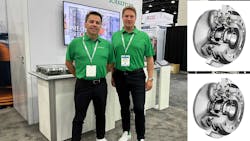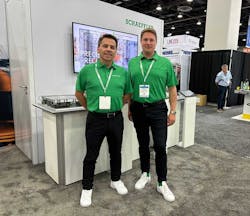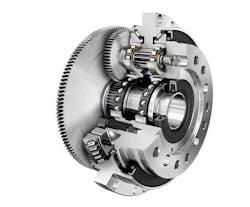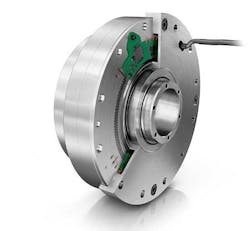Gearing up at Automate 2023: Schaeffler Showcases Latest Components for Robotics
As the demand for AI-driven solutions in the robotics industry rises, so does the strain on the hardware.
For companies like Schaeffler, the opportunity to bring new system components—precision gearboxes, pivot bearing supports, drive motors, sensors as well as the robotic 7th axis—to the Automate 2023 is invaluable.
A relative newcomer to the robotics space, the company first entered the arena around 2018. That’s when Nicolai Haemmerle, vice president, Business Field Robotics, Schaeffler, and his colleague, the regional CTO, realized the hype building around cobots.
“In Tokyo, you could go to a café and have a cobot make coffee, and that was a great thing to experience,” Haemmerle said. “And we thought, why don’t we actually give it a shot? We’ve got the technology and the market is growing rapidly, especially on the cobot side. More and more applications are being conquered by sensor technology. We also see a lot of opportunities because Schaeffler has 75 plants globally.”
Haemmerle characterized the idea to expand into the robotics and automation market as “genius” because Schaeffler has avoided adding any additional components to the system.
“We use the existing components of the mechanical gear and apply the sensor directly into the gear,” Haemmerle explained. “We use the flex spline with the strain wave gear and apply the sensor structure directly onto the flange by coating layers onto it. We etch out the sensor structure using a laser and that way we’re actually able to apply the laser sensor directly in the gear box.
“We don’t add any additional design space or any additional parts, and we have a high stiffness, which is important for our customers,” he continues. “We don’t reduce the torsional stiffness, and we have the highest accuracy of the sensor signals. It’s a win-win for all of us. And overall, the market response has been amazing.”
Sensors Make the Difference
The opportunity to answer the market’s call for solutions can be addressed through the development and integration of sensor technology. In this respect, Schaeffler’s sensor-based components can be viewed from two topics, said Haemmerle.
The first is in the sensor design itself. “What we have done is we’ve actually merged multiple sensors inside the system,” explained Haemmerle, who flew in from Germany to be at the Detroit show. “And these are read out by two completely separate software clusters, one being a deep learning algorithm.” Engineers use the data to evaluate the mechanical effects from the gear itself and filter it, he said.
An additional input is that each gearbox is trained on an end-of-line test at the point of manufacturing. “Basically, the algorithm is trained over the entire torque range of different revolutions. That is adapted specifically for the gear set, with the right tolerance, and so that we can always ensure that we have the maximum accuracy readout.”
The second software cluster serves as a redundancy test. “It’s just standard, basic software tests that validate if the AI algorithm is actually working correctly, to confirm whether signals are valid, and so we can process it and send it out to the interface of our customer,” he said.
The following components are highlighted at Schaeffler’s booth (#841):
Haemmerle pointed out that the PSC gear units feature a patented tooth system that reduces torsional backlash to less than 0.1 angular minutes—a value that remains constant throughout the device’s entire operating life of 20,000 hours.
Encompassing five sizes, Schaeffler’s standard-duty RT2-series strain wave gears cover about 80% of normal cobot applications. Other variants and configurations are available, too.
Designed for high-torque applications up to 900 Nm, Schaeffler’s heavy-duty RT1 gear units are currently offered in four sizes. The low weight and compact design make them ideal for use in cobots. The RT1’s backlash-free and wear-resistant gear teeth ensure excellent positional accuracies throughout the unit’s entire operating life.
Looking Ahead
This is the first year that Schaeffler is exhibiting at Automate, said Gregory Falco, communications and branding specialist at the company. “Schaeffler is growing both organically but also through acquisition, and some of the solutions that we’re showing came with through a recent acquisition of Melior Motion and the development of our strain wave gearbox with its integrated torque measuring system.”
Editor’s Note: A3, the organizers of Automate 2023, have confirmed the annual show will be held at McCormick Place in Chicago May 6-9, 2024 and will return to Huntington Place in Detroit in 2025.
About the Author

Rehana Begg
Editor-in-Chief, Machine Design
As Machine Design’s content lead, Rehana Begg is tasked with elevating the voice of the design and multi-disciplinary engineer in the face of digital transformation and engineering innovation. Begg has more than 24 years of editorial experience and has spent the past decade in the trenches of industrial manufacturing, focusing on new technologies, manufacturing innovation and business. Her B2B career has taken her from corporate boardrooms to plant floors and underground mining stopes, covering everything from automation & IIoT, robotics, mechanical design and additive manufacturing to plant operations, maintenance, reliability and continuous improvement. Begg holds an MBA, a Master of Journalism degree, and a BA (Hons.) in Political Science. She is committed to lifelong learning and feeds her passion for innovation in publishing, transparent science and clear communication by attending relevant conferences and seminars/workshops.
Follow Rehana Begg via the following social media handles:
X: @rehanabegg
LinkedIn: @rehanabegg and @MachineDesign



